Fringilla teydea
 |
| (Photo from Wikipedia) |
Common name:
blue chaffinch (en); tentilhão-azul (pt); pinson blue (fr); pinzón azul (es); Teydefink (de)
Taxonomy:
Order Passeriformes
Family Fringillidae
Range:
This species is endemic to the islands of Tenerife and Gran Canaria in the Canary islands.
Size:
These birds are 16-18 cm long and weigh 30-31 g.
Habitat:
The blue chaffinch is most common in coniferous forests with dense undergrowth, but it is also found in laurel and pine woodland, tree-heath, and scrub. They are present at altitudes of 1.100–2.000 m, but may move to lower altitudes during harsh winters.
Diet:
Their main food source are pine seeds which they eat both in the trees and on the ground, extracting the seeds from the half-open cones by breaking them open with
their thick, powerful bills. They also eat other seeds and fruits, as well as nocturnal butterflies and beetles taken from cracks in pine bark.
Breeding:
The blue chaffinch breeds in April-July. The nest is built by the female, using pine needles and branches of broom Chamaecytisus proliferus and lined with moss, feathers, grasses and rabbit hair. The nest is usually located in pine trees or sometimes in heath Erica arborea or laurel Laurus azorica. The female lays 1-2 eggs, which she incubates alone for 14-16 days. The chicks are fed by both the parents and fledge 17-18 days after hatching.
Conservation:
IUCN status – NT (Near-Threatened)
This species has a small breeding range and a global population of just 2.000-5.000 individuals. Although the tiny population on Gran Canaria continues to decline, it represents a small proportion of the global population, and overall trends are thought to be positive as the area of suitable habitat increases on Tenerife. The blue chaffinch is threatened by illegal capture and trade, as well as intense commercial exploitation of pine forests. Forest fires also have a negative impact on this species.







